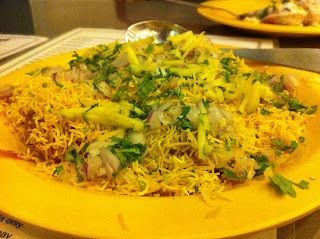The endless dirt and the hustle and bustle of Bombay can really get to you sometimes. Every time I need to escape, I venture out to one of the many restaurants that have the ability to make you feel as if you are elsewhere. The Table — an award-winning restaurant with the best European/global cuisine, best wine list and listed as one of the top 50 restaurants in Mumbai, manages to do this for me every single time. The creative dishes and eclectic decor is what keeps me coming back.
As soon as I entered the upscale, two-story restaurant, I was enthralled by the black-and-white zig-zag floor and green armchairs. The ambiance is posh but not uptight; trendy but not pretentious.
The menu consists of small and large plates. I felt lost when scrutinizing the menu as every item seemed equally titillating. So, we decided to order a bunch of dishes for the table and share. The rather extensive wine list was intimidating so we asked our waiter to select a light-bodied red wine for us. He suggested the Domaine Montrose Merlot, Vin de Pays de Pays de L’herault, South of France, France 2010 (Rs. 3000), which ended up complementing our meal perfectly.
If you're a fan of brussel sprouts, you must try these as they are divine (Rs. 425). The sprouts are roasted in two sauces: a brown butter sauce and an emulsioned sauce with a twist — garnished with crunchy chestnuts.
The zucchini spaghetti (Rs. 450) was so innovative and so low-cal! Instead of using wheat pasta, they used zucchinis and peeled them into long strands. It was then tossed in a a butter sauce, and sprinkled with almonds and parmesan cheese. I loved how the zucchini was cooked al dente — firm but not hard, chewy but not brittle.
The roasted red beets salad (Rs 425) featured goat cheese, oranges, mints and pine nuts. The rich maroon color of the beets combined with the bright orange color of the fruit looked spectacular, especially because of the melange of vivid colors. Its taste managed to exceed its presentation, which I did not think was possible!
The yellowfin tuna tataki was drizzled in a sesame vinaigrette, fused with cold diced avocados and topped with fried, round radish slices. The combination of the fresh and juicy sashimi, creamy avacado and crispy radishes offered a mouthful of fine contrasts in textures and flavors.
Because of my love for Japanese anything, I made sure to order both the miso dishes on the menu. One was a small plate — miso-glazed eggplant (Rs. 425) and the other a large — grouper roasted in Japanese-aromatics (Rs. 725). The eggplant was sliced in long strips and coated in a miso-yogurt sauce that added the perfect amount of moisture to the vegetable. The grouper simply melted in my mouth. The tender and buttery fish laid upon a bed of spinach and submerged in a spring onion fondue that kept the intensity of the flavor just right.












